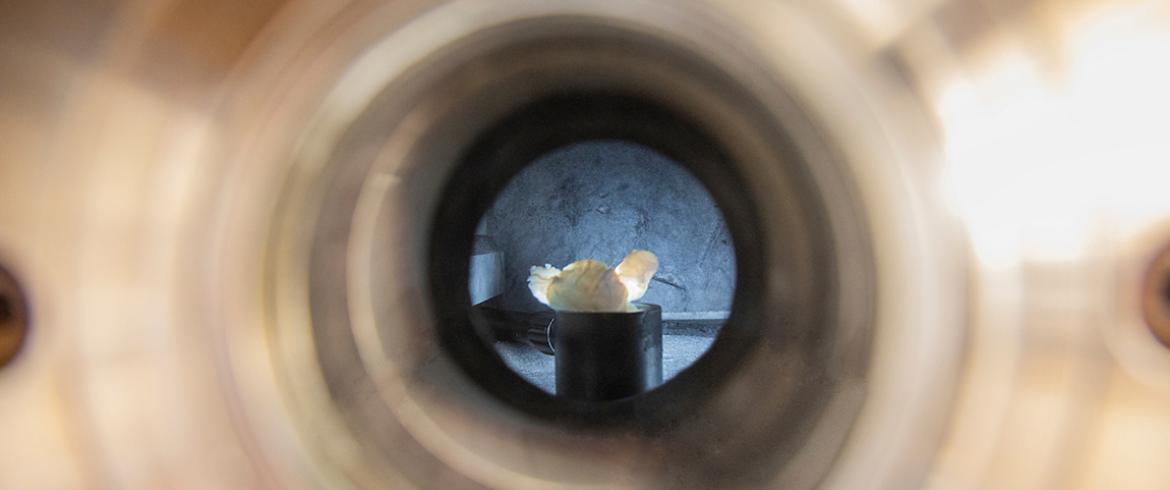
BNNT material in a crucible for heating at the High-Performance Materials Institute (HPMI). (M Wallheiser/FAMU-FSU Engineering)
A team of FAMU-FSU College of Engineering researchers at the High-Performance Materials Institute (HPMI) has completed a novel study on the extreme temperature thermal stability of purified boron nitride nanotubes, also known as BNNTs. The discovery has applications in everything from deep space travel to medicine delivery systems, including electronics.

BNNTs have been studied extensively, but no one has determined the decomposition mechanism, according to the researchers. The group analyzed the properties of BNNTs in an inert atmosphere similar to the conditions used in the manufacturing process for high-temperature nanocomposites.
Rebekah Sweat, an assistant professor in industrial and manufacturing engineering at the college, worked with lead author Mehul Tank and several engineering graduate students, as well as with scientists from the BNNT Materials on the study.
“After a literature review, found that no one knew exactly where BNNTs degrade in inert environments,” Sweat said. “BNNTs are materials that can withstand extremely high temperatures and radiation environments.”
“Understanding BNNT behavior at high temperatures will eventually lead to the effective manufacturing of composites that employ high-temperature processing matrices, like ceramics and metals,” Tank explained.
There are many applications for these composites. Anything that gets hot, like a turbine or engine, might use them to reinforce a composite material. They are thermally conducting, which means they spread heat out quickly. They are mechanically stable and offer structural reinforcement.
“Manufactured composites are comprised of a reinforcement and a matrix, and when manufacturing high-temperature materials, the process itself can degrade the material,” Sweat said. “However, BNNTs are a robust reinforcement material, and now we can provide quantitative temperature guidelines for these manufacturing processes.”

The researchers demonstrated that BNNTs are fully stable at 1800°C in an inert environment and can withstand temperatures at 2200°C for short periods. The material used to manufacture composites must withstand the process without losing its unique mechanical properties.
The journal Applied Nano Materials recently published their work.
“In deep space, in a radiation-rich environment such as a spacecraft during reentry, BNNTs can withstand a lot of heat and radiation,” Sweat said. “They are lightweight, making them suited for space vehicles or hypersonics in harsh environments.”
BNNTs have a unique combination of thermal conduction, electrical insulation and radiation shielding properties, along with high-temperature stability that opens a wide range of space instrument applications. They could be used in space rovers and high-temperature electronics.
“This research is about uncovering a property that is incredibly useful for the future,” Sweat said. “We have a more robust knowledge of how BNNTs perform when they fail and how they fail—because materials do fail. We have changed how we make these types of composites to better utilize their properties.”
Along with space applications, BNNTs have enormous potential to form thermally conductive and electrically insulative layers on circuit boards for efficient heat dissipation in electronics.
The study was supported by Florida State University Faculty-Affiliated startup funds from the Office of Commercialization and BNNT Materials. Ana De Leon, Aspen Reyes, Jin Gyu Park, Lyndsey Scammell, and Michael Smith collaborated with Sweat and Tank on the project.
The High-Performance Materials Institute is a multidisciplinary research facility at FSU closely aligned with the FAMU-FSU College of Engineering. It is a leading center of excellence for research and education for advanced materials. The HPMI center works with aerospace, automotive, energy, 3-D printing, electronics, sports technology and biomedical areas of interest.
RELATED ARTICLES
Engineering Researchers Win Commercialization Funding from FSU
Special University Funding Takes Polymer Testing Innovation to the Next Level
